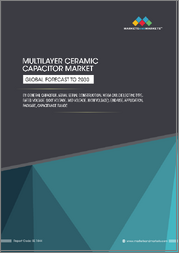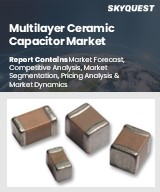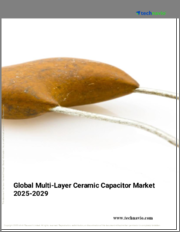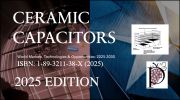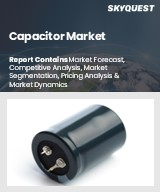
|
시장보고서
상품코드
1798084
세라믹 커패시터 시장 예측(-203년) : 유형별, 정전용량별, 최종사용자별, 지역별 세계 분석Ceramic Capacitor Market Forecasts to 2032 - Global Analysis By Type (Multilayer Ceramic Chip Capacitor (MLCC), Ceramic Disc Capacitor, Feedthrough Ceramic Capacitor and Ceramic Power Capacitor), Capacitance Value, End User and By Geography |
||||||
Stratistics MRC에 의하면, 세라믹 커패시터 세계 시장은 2025년에 186억 5,000만 달러를 차지하고, 예측 기간 중에 CAGR 14.58%로 성장하여 2032년에는 483억 4,000만 달러에 이를 전망입니다.
세라믹 커패시터는 일반적인 전자 부품으로, 세라믹을 유전체로 사용하여 회로 내 전기 에너지를 저장하고 방출하는 역할을 합니다. 세라믹 커패시터는 소형, 저비용, 고신뢰성으로 인해 가전제품부터 산업 및 자동차 시스템까지 다양한 분야에서 널리 사용되고 있습니다. 세라믹 커패시터에는 단층형과 컴팩트한 형태로 높은 커패시턴스를 제공하는 적층 세라믹 커패시터(MLCC) 등 여러 유형이 있습니다. 이 세라믹 커패시터는 우수한 주파수 특성, 기생 효과 최소화, 고온 및 고전압 환경에서의 효과적인 작동 능력으로 유명합니다. 또한, 이러한 특성으로 인해 신호처리, 커플링, 디커플링, 노이즈 필터링 등 다양한 전자기기 용도에 필수적인 커패시터로 사용되고 있습니다.
JEITA의 '세계 전자제품 생산 예측'에 따르면, 일본 전자 IT 기업의 전자부품 생산은 자동차용 일렉트로닉스, 반도체, 솔루션 서비스 수요에 힘입어 2024년에는 전년 대비 6% 성장할 것으로 예상되고 있습니다.
가전제품 수요 증가와 소형화 추세
세라믹 커패시터 시장 확대를 이끄는 주요 요인 중 하나는 전자제품의 소형화가 지속적으로 추진되고 있다는 점입니다. 웨어러블, 노트북, 태블릿, 스마트폰, AR/VR 기기 등 최신 기기에서는 더 작고 더 강력한 부품이 점점 더 많이 요구되고 있습니다. 특히 적층 세라믹 커패시터(MLCC)는 소형 패키징으로 높은 정전 용량을 제공하므로 설계자가 더 얇은 기기에 더 많은 기능을 통합할 수 있습니다. 스마트폰에만 1,000개에 가까운 커패시터가 사용되며, 플래그십 모델에는 RF 모듈, 카메라, 오디오 시스템, 화면을 지원하기 위해 1,000개 이상의 커패시터가 사용됩니다. 소비자 기기에 5G, AI, IoT 기능이 탑재됨에 따라 초소형 고성능 MLCC에 대한 수요는 계속 증가하고 있습니다.
가격 변동과 공급망 제약
원자재 가격 변동과 공급망 중단은 세라믹 커패시터 시장을 제한하는 두 가지 주요 요인입니다. 바륨 티타네이트나 팔라듐과 같은 희토류 원소는 모두 세계 공급 변동에 영향을 받지만, 세라믹 커패시터에 없어서는 안 될 필수 요소입니다. 지정학적 긴장, 수출 규제, 중국, 러시아 등의 채굴 제한으로 인해 악화되는 가용성 문제로 인해 가격이 불안정합니다. 또한, MLCC 제조에는 고도로 정교한 제조기술이 필요하고 공급업체가 적어 수요가 많은 시기에는 병목현상이 발생하기도 합니다. 이러한 약점은 코로나19 사태로 인해 드러나게 되었습니다. 제품 부족은 자동차, 산업, 가전제품 부문의 생산을 지연시키고 시장의 안정을 저해했기 때문입니다.
자율주행차와 전기자동차의 성장
세라믹 커패시터 시장은 전기자동차의 급속한 보급과 자율주행차의 지속적인 발전으로 큰 잠재력을 가지고 있습니다. 배터리 관리, 인버터, DC-DC 컨버터, 인포테인먼트, 자동차 충전기 등의 시스템을 지원하기 위해 전기자동차에는 수천 개의 커패시터가 필요합니다. 고전압, 고신뢰성 MLCC의 필요성은 특히 중국, 유럽, 북미 등 전 세계적으로 전기차 보급이 확대됨에 따라 더욱 높아질 것으로 예측됩니다. 자율주행차는 레이더, LiDAR, 카메라 시스템, 첨단 운전 보조 기능이 신호 필터링과 전력 안정성을 위해 커패시터에 크게 의존하고 있기 때문에 이 요건을 더욱 강화할 것입니다. 세라믹 커패시터 제조업체는 정부가 전기차 도입에 대한 인센티브를 제공하고 전 세계적으로 배기가스 규제가 강화됨에 따라 큰 이익을 얻을 수 있는 위치에 있습니다.
원료 부족과 희토류 의존도
세라믹 커패시터 시장은 팔라듐과 같은 귀금속과 바륨 티타네이트와 같은 희토류 원소에 대한 의존으로 인해 심각한 위협을 받고 있습니다. 이들 자원은 중국과 러시아를 중심으로 한 소수의 국가에 집중되어 있어 무역 리스크와 지정학적 리스크가 존재합니다. 채굴 제한, 수출 제한, 정치적 불안 등이 발생하면 세계 공급망은 심각한 혼란에 빠질 수 있습니다. 커패시터의 가격과 수익성은 원재료가 제조 원가의 상당 부분을 차지하기 때문에 급격한 가격 상승에 직접적인 영향을 받고 있습니다. 예를 들어, MLCC 제조업체는 최근 팔라듐 가격 변동으로 인해 공급이 불안정해졌습니다. 장기적인 지속가능성의 문제는 이러한 유한한 자원에 대한 과도한 의존으로 인해 발생합니다.
코로나19의 영향
코로나19 사태는 세라믹 커패시터 시장에 두 가지 영향을 미쳤다: 첫째, 큰 혼란을 일으켰고, 둘째, 회복과 확장의 기회를 창출했습니다. MLCC 부족과 전자, 자동차, 산업 생산 지연은 초기 단계에 중국, 일본, 한국 등 주요 제조 거점의 공장 가동 중단으로 인한 결과이며, 이는 전 세계 공급망에 큰 영향을 미쳤습니다. 소매업의 판매 둔화로 인해 가전제품 수요가 일시적으로 감소했고, 자동차 산업에서는 자동차 생산량이 급감했습니다. 그러나 팬데믹은 디지털 전환을 가속화하여 노트북, 스마트폰, IoT 기기, 의료용 전자기기 등 세라믹 커패시터에 크게 의존하는 기기 수요를 증가시켰습니다.
적층 세라믹 칩 커패시터(MLCC) 부문이 예측 기간 동안 가장 큰 시장으로 부상할 것으로 예측됩니다.
적층 세라믹 칩 커패시터(MLCC) 부문은 예측 기간 동안 가장 큰 시장 점유율을 차지할 것으로 예측됩니다. MLCC는 작은 크기, 높은 커패시턴스 값, 신뢰성, 저렴한 가격으로 인해 웨어러블 기술, 자동차 전자, 통신, 산업 장비, 스마트폰, 노트북, 태블릿 및 기타 장치에 널리 사용되고 있습니다. 에너지 저장, 필터링, 디커플링 등의 목적으로 현대 전자기기에는 수백에서 수천 개의 MLCC가 자주 내장되어 있습니다. 특히 5G, IoT, 전기자동차의 출현과 함께 소형 설계로 우수한 주파수 특성과 안정성을 제공할 수 있어 널리 채택되고 있습니다. 따라서 MLCC는 시장의 선두주자이자 모든 부문에서 성장의 주요 원동력이 되고 있습니다.
예측 기간 동안 가장 높은 CAGR을 보일 것으로 예상되는 자동차 부문
예측 기간 동안 자동차 부문이 가장 높은 성장률을 보일 것으로 예측됩니다. 전기자동차(EV), 하이브리드 자동차, 인포테인먼트와 첨단운전자보조시스템(ADAS)의 통합 확대가 이러한 성장의 주요 원동력이 되고 있습니다. 수천 개의 세라믹 커패시터는 배전 시스템, 인버터, 자동차 충전기, 모든 EV의 배터리 관리 등 중요한 부품에 필요합니다. 고전압, 고신뢰성 MLCC는 전동화 추세와 커넥티드카 및 자율주행차 수요 증가로 인해 그 필요성이 더욱 커지고 있습니다. 또한, 친환경 모빌리티를 촉진하기 위한 세계 각국 정부의 이니셔티브와 자동차 제조업체들의 전기차 기술에 대한 대규모 투자로 인해 자동차 산업은 앞으로도 가장 빠른 속도로 성장할 것으로 보입니다.
가장 큰 점유율을 차지하는 지역
예측 기간 동안 아시아태평양이 가장 큰 시장 점유율을 차지할 것으로 예측됩니다. 이는 다양한 산업에서 높은 소비가 있고, 전자제품 제조 생태계가 견고하기 때문입니다. 적층세라믹커패시터(MLCC)는 주로 중국, 일본, 한국, 대만에서 생산 및 수출되고 있으며, 가전, 자동차, 통신 산업의 유명 국제 브랜드에 공급되고 있습니다. 이 지역의 발전은 스마트폰 제조의 리더십, 5G 인프라의 빠른 발전, 전기자동차의 인기 상승으로 더욱 강화되고 있습니다. 또한, 아시아태평양은 최고의 커패시터 제조업체와 탄탄한 공급망의 본거지이기 때문에 세계 세라믹 커패시터 시장에서 생산과 수요의 주요 중심지입니다.
CAGR이 가장 높은 지역
예측 기간 동안 북미가 가장 높은 CAGR을 보일 것으로 예측됩니다. 이는 민생, 통신, 자동차 산업에서 첨단 전자기기의 사용이 증가하고 있기 때문입니다. 이 지역에서는 5G 인프라, 스마트 기기, 전기자동차에 고성능 커패시터가 빠르게 채택되면서 수요가 증가하고 있습니다. 강력한 R&D 투자와 활발한 전자제품 제조 생태계를 바탕으로 미국은 가장 큰 기여를 하는 국가로 남아있습니다. 가전제품 소비 증가와 산업 응용 분야 확대가 캐나다와 멕시코의 괄목할 만한 성장을 주도하고 있습니다. 북미는 기술 혁신, 인프라 구축, 지속 가능한 에너지 솔루션에 중점을 두고 있어 세계 세라믹 커패시터 시장 전체에서 주요 성장 허브로 자리매김하고 있습니다.
무료 커스터마이징 서비스
본 보고서를 구독하는 고객은 다음과 같은 무료 맞춤화 옵션 중 하나를 이용할 수 있습니다.
- 기업 소개
- 추가 시장 진출기업의 종합적인 프로파일링(최대 3개사까지)
- 주요 기업의 SWOT 분석(3개사까지)
- 지역 세분화
- 고객의 관심에 따른 주요 국가별 시장 추정 및 예측, CAGR(주: 타당성 확인에 따라 다름)
- 경쟁사 벤치마킹
- 제품 포트폴리오, 지리적 입지, 전략적 제휴를 통한 주요 기업 벤치마킹
목차
제1장 주요 요약
제2장 서문
- 개요
- 이해관계자
- 조사 범위
- 조사 방법
- 데이터 마이닝
- 데이터 분석
- 데이터 검증
- 조사 접근
- 조사 자료
- 1차 조사 자료
- 2차 조사 자료
- 전제조건
제3장 시장 동향 분석
- 서론
- 성장 촉진요인
- 성장 억제요인
- 기회
- 위협
- 최종사용자 분석
- 신흥 시장
- COVID-19의 영향
제4장 Porter의 Five Forces 분석
- 공급 기업의 교섭력
- 바이어의 교섭력
- 대체품의 위협
- 신규 진출업체의 위협
- 경쟁 기업간 경쟁 관계
제5장 세계의 세라믹 커패시터 시장 : 유형별
- 서론
- 적층 세라믹 칩 커패시터(MLCC)
- 세라믹 디스크 커패시터
- 관통형 세라믹 커패시터
- 세라믹 파워 커패시터
제6장 세계의 세라믹 커패시터 시장 : 정전용량별
- 서론
- 저용량
- 중용량
- 고용량
제7장 세계의 세라믹 커패시터 시장 : 최종사용자별
- 서론
- 가전제품
- 자동차
- 통신
- 산업 장비
- 에너지 및 전력
- 기타
제8장 세계의 세라믹 커패시터 시장 : 지역별
- 서론
- 북미
- 미국
- 캐나다
- 멕시코
- 유럽
- 독일
- 영국
- 이탈리아
- 프랑스
- 스페인
- 기타 유럽
- 아시아태평양
- 일본
- 중국
- 인도
- 호주
- 뉴질랜드
- 한국
- 기타 아시아태평양
- 남미
- 아르헨티나
- 브라질
- 칠레
- 기타 남미
- 중동 및 아프리카
- 사우디아라비아
- 아랍에미리트(UAE)
- 카타르
- 남아프리카공화국
- 기타 중동 및 아프리카
제9장 주요 개발
- 계약/파트너십/협업/합작투자(JV)
- 인수와 합병
- 신제품 발매
- 사업 확대
- 기타 주요 전략
제10장 기업 프로파일링
- Murata Manufacturing Co., Ltd
- Kyocera Corporation
- Maruwa Co., Ltd.
- Panasonic Corporation
- Frontier Electronics Corp.
- Samsung Electro-Mechanics Co., Ltd
- Johanson Dielectrics, Inc.
- Taiyo Yuden Co., Ltd.
- Vishay Intertechnology Inc.
- AVX Corporation
- Walsin Technology Corporation
- TDK Corporation
- Kemet Corporation
- Yageo Corporation
- TE Connectivity
According to Stratistics MRC, the Global Ceramic Capacitor Market is accounted for $18.65 billion in 2025 and is expected to reach $48.34 billion by 2032 growing at a CAGR of 14.58% during the forecast period. A ceramic capacitor is a common electronic component that uses ceramic as its dielectric to store and release electrical energy in a circuit. It is a popular option in applications ranging from consumer electronics to industrial and automotive systems because of its small size, low cost, and high reliability. There are several types of ceramic capacitors, including single-layer versions for easier applications and multilayer ceramic capacitors (MLCCs), which provide high capacitance in compact forms. They are renowned for having outstanding frequency characteristics, minimal parasitic effects, and the capacity to operate effectively in high-temperature and high-voltage settings. Moreover, these characteristics make ceramic capacitors indispensable for various electronic device applications, including signal processing, coupling, decoupling, and noise filtering.
According to JEITA's Global Electronics Production Forecast, Production of electronic components by Japanese electronics and IT companies is expected to grow 6% year-on-year in 2024, driven by demand in automotive electronics, semiconductors, and solution services.
Market Dynamics:
Driver:
Growing demand and miniaturization in consumer electronics
One of the main factors propelling the ceramic capacitor market's expansion is the unrelenting push for electronics miniaturization. Smaller but more powerful components are becoming more and more necessary for modern devices like wearables, laptops, tablets, smartphones, and AR/VR equipment. This need is met by ceramic capacitors, particularly multilayer ceramic capacitors (MLCCs), which provide high capacitance in small packages, enabling designers to incorporate more functionality into devices that are thinner. Nearly a thousand capacitors can be found in smartphones alone, and flagship models use well over a thousand to support RF modules, cameras, audio systems, and screens. The need for ultra-compact, high-performance MLCCs keeps growing as consumer devices incorporate 5G, AI, and IoT features.
Restraint:
Price fluctuations and supply chain limitations
Price fluctuations for raw materials and supply chain interruptions are two of the main factors limiting the ceramic capacitor market. Rare earth elements like barium titanate and palladium, which are both subject to worldwide supply fluctuations, are essential components of ceramic capacitors. Price instability results from availability problems that are made worse by geopolitical tensions, export restrictions, and mining limitations in nations like China and Russia. Furthermore, producing MLCCs necessitates highly sophisticated manufacturing techniques with few suppliers, which frequently results in bottlenecks during periods of high demand. These weaknesses were brought to light by the COVID-19 pandemic, as shortages hindered market stability by delaying production in the automotive, industrial, and consumer electronics sectors.
Opportunity:
Growth in autonomous and electric vehicles
The ceramic capacitor market has enormous potential due to the quick uptake of electric vehicles and the continuous advancement of autonomous vehicles. In order to support systems like battery management, inverters, DC-DC converters, infotainment, and onboard chargers, electric vehicles need thousands of capacitors. The need for high-voltage, high-reliability MLCCs will increase as EV adoption increases worldwide, especially in China, Europe, and North America. With radar, LiDAR, camera systems, and sophisticated driver-assistance features relying largely on capacitors for signal filtering and power stability, autonomous cars further raise this requirement. Ceramic capacitor producers stand to gain greatly from governments providing incentives for EV adoption and more stringent emission standards globally.
Threat:
Lack of raw materials and reliance on rare earths
The market for ceramic capacitors is seriously threatened by its reliance on precious metals like palladium and rare earth elements like barium titanate. Because these resources are concentrated in a small number of nations, mostly China and Russia, there are trade and geopolitical risks. Global supply chains can be seriously disrupted by any mining restrictions, export restrictions, or political unrest. Capacitor pricing and profitability are directly impacted by abrupt price increases because raw materials make up a significant amount of production costs. For instance, MLCC manufacturers experienced supply instability as a result of recent palladium price fluctuations. Long-term sustainability issues are brought on by this excessive reliance on finite resources.
Covid-19 Impact:
The COVID-19 pandemic affected the ceramic capacitor market in two ways: first, it caused major disruptions, but later, it created chances for recovery and expansion. MLCC shortages and delays in electronics, automotive, and industrial production were the results of factory shutdowns in major manufacturing hubs such as China, Japan, and South Korea in the early stages, which had a significant impact on global supply chains. As retail sales slowed, consumer electronics demand temporarily decreased, and the automotive industry saw a steep drop in vehicle production. But the pandemic also sped up digital transformation, increasing demand for devices that heavily relied on ceramic capacitors, such as laptops, smart phones, IoT devices, and medical electronics, which helped the market, recover well by the end of 2021.
The multilayer ceramic chip capacitor (MLCC) segment is expected to be the largest during the forecast period
The multilayer ceramic chip capacitor (MLCC) segment is expected to account for the largest market share during the forecast period. MLCCs are widely used in wearable technology, automobile electronics, telecommunications, industrial equipment, smartphones, laptops, tablets, and other devices because of their small size, high capacitance values, dependability, and affordability. For purposes like energy storage, filtering, and decoupling, hundreds to thousands of MLCCs are frequently integrated into contemporary electronic devices. They have been widely adopted due to their ability to provide excellent frequency characteristics and stability in small designs, especially with the emergence of 5G, IoT, and electric vehicles. MLCCs are therefore the market leaders and remain the primary engine of growth in all sectors.
The automotive segment is expected to have the highest CAGR during the forecast period
Over the forecast period, the automotive segment is predicted to witness the highest growth rate. Electric vehicles (EVs), hybrid cars, and the growing integration of infotainment and advanced driver-assistance systems (ADAS) are the main drivers of this growth. Thousands of ceramic capacitors are needed for vital components like power distribution systems, inverters, onboard chargers, and battery management in every EV. High-voltage and high-reliability MLCCs are now much more necessary due to the electrification trend and the rising demand for connected and autonomous vehicles. Moreover, the automotive industry will continue to grow at the fastest rate due to global government initiatives to promote greener mobility and automakers' significant investments in EV technology.
Region with largest share:
During the forecast period, the Asia-Pacific region is expected to hold the largest market share, driven by its high consumption across a variety of industries and robust ecosystem for electronics manufacturing. Multilayer ceramic capacitors (MLCCs) are produced and exported primarily by China, Japan, South Korea, and Taiwan, and they supply well-known international brands in the consumer electronics, automotive, and telecommunications industries. The region's market position is further reinforced by its leadership in smart phone manufacturing, quick development of 5G infrastructures, and growing popularity of electric vehicles. Additionally, Asia-Pacific is the primary center for both production and demand in the global ceramic capacitor market because it is home to top capacitor manufacturers and established supply chains.
Region with highest CAGR:
Over the forecast period, the North American region is anticipated to exhibit the highest CAGR, driven by the growing use of sophisticated electronics in the consumer, telecommunications, and automotive industries. Demand is being boosted by the region's fast adoption of high-performance capacitors in 5G infrastructure, smart devices, and electric cars. Supported by strong R&D investments and a thriving electronics manufacturing ecosystem, the United States continues to be the largest contributor. Rising consumer electronics consumption and growing industrial applications are driving significant growth in Canada and Mexico as well. North America is positioned as a major growth hub in the global ceramic capacitor market overall thanks to its emphasis on technological innovation, infrastructure improvements, and sustainable energy solutions.
Key players in the market
Some of the key players in Ceramic Capacitor Market include Murata Manufacturing Co., Ltd, Kyocera Corporation, Maruwa Co., Ltd., Panasonic Corporation, Frontier Electronics Corp., Samsung Electro-Mechanics Co., Ltd, Johanson Dielectrics, Inc., Taiyo Yuden Co., Ltd., Vishay Intertechnology Inc., AVX Corporation, Walsin Technology Corporation, TDK Corporation, Kemet Corporation, Yageo Corporation and TE Connectivity.
Key Developments:
In July 2025, YAGEO has launched a tender offer to acquire the shares of Shibaura Electronics Co., ltd., a globally recognized leader in NTC (negative temperature coefficient) thermistor manufacturing with strong technological capabilities.
In February 2025, Murata Electronics (India) Private Limited has signed an agreement to lease a factory at the OneHub Chennai Industrial Park, Tamil Nadu. The Japanese firm will commence full-scale operation in financial year 2026. Tamil Nadu's Industries Minister T.R.B. Rajaa posted a message on X, saying: "Japanese electronics giant Murata Manufacturing has entered Tamil Nadu with a factory at OneHub Chennai Industrial Park to manufacture multilayer ceramic capacitors.
In July 2024, Panasonic Corporation announced that its Cold Chain Solutions Company has entered into an agreement with Cooling Solutions S.L. to purchase all the shares of its subsidiary Area Cooling Solutions Sp. z o.o. , a Polish refrigeration equipment manufacturer. This transaction is a strategic step for Panasonic to strengthen its condensing unit business in the European market and to accelerate its ongoing global expansion.
Types Covered:
- Multilayer Ceramic Chip Capacitor (MLCC)
- Ceramic Disc Capacitor
- Feedthrough Ceramic Capacitor
- Ceramic Power Capacitor
Capacitance Values Covered:
- Low Capacitance
- Medium Capacitance
- High Capacitance
End Users Covered:
- Consumer Electronics
- Automotive
- Telecommunications
- Industrial Equipment
- Energy & Power
- Other End Users
Regions Covered:
- North America
- US
- Canada
- Mexico
- Europe
- Germany
- UK
- Italy
- France
- Spain
- Rest of Europe
- Asia Pacific
- Japan
- China
- India
- Australia
- New Zealand
- South Korea
- Rest of Asia Pacific
- South America
- Argentina
- Brazil
- Chile
- Rest of South America
- Middle East & Africa
- Saudi Arabia
- UAE
- Qatar
- South Africa
- Rest of Middle East & Africa
What our report offers:
- Market share assessments for the regional and country-level segments
- Strategic recommendations for the new entrants
- Covers Market data for the years 2024, 2025, 2026, 2028, and 2032
- Market Trends (Drivers, Constraints, Opportunities, Threats, Challenges, Investment Opportunities, and recommendations)
- Strategic recommendations in key business segments based on the market estimations
- Competitive landscaping mapping the key common trends
- Company profiling with detailed strategies, financials, and recent developments
- Supply chain trends mapping the latest technological advancements
Free Customization Offerings:
All the customers of this report will be entitled to receive one of the following free customization options:
- Company Profiling
- Comprehensive profiling of additional market players (up to 3)
- SWOT Analysis of key players (up to 3)
- Regional Segmentation
- Market estimations, Forecasts and CAGR of any prominent country as per the client's interest (Note: Depends on feasibility check)
- Competitive Benchmarking
- Benchmarking of key players based on product portfolio, geographical presence, and strategic alliances
Table of Contents
1 Executive Summary
2 Preface
- 2.1 Abstract
- 2.2 Stake Holders
- 2.3 Research Scope
- 2.4 Research Methodology
- 2.4.1 Data Mining
- 2.4.2 Data Analysis
- 2.4.3 Data Validation
- 2.4.4 Research Approach
- 2.5 Research Sources
- 2.5.1 Primary Research Sources
- 2.5.2 Secondary Research Sources
- 2.5.3 Assumptions
3 Market Trend Analysis
- 3.1 Introduction
- 3.2 Drivers
- 3.3 Restraints
- 3.4 Opportunities
- 3.5 Threats
- 3.6 End User Analysis
- 3.7 Emerging Markets
- 3.8 Impact of Covid-19
4 Porters Five Force Analysis
- 4.1 Bargaining power of suppliers
- 4.2 Bargaining power of buyers
- 4.3 Threat of substitutes
- 4.4 Threat of new entrants
- 4.5 Competitive rivalry
5 Global Ceramic Capacitor Market, By Type
- 5.1 Introduction
- 5.2 Multilayer Ceramic Chip Capacitor (MLCC)
- 5.3 Ceramic Disc Capacitor
- 5.4 Feedthrough Ceramic Capacitor
- 5.5 Ceramic Power Capacitor
6 Global Ceramic Capacitor Market, By Capacitance Value
- 6.1 Introduction
- 6.2 Low Capacitance
- 6.3 Medium Capacitance
- 6.4 High Capacitance
7 Global Ceramic Capacitor Market, By End User
- 7.1 Introduction
- 7.2 Consumer Electronics
- 7.3 Automotive
- 7.4 Telecommunications
- 7.5 Industrial Equipment
- 7.6 Energy & Power
- 7.7 Other End Users
8 Global Ceramic Capacitor Market, By Geography
- 8.1 Introduction
- 8.2 North America
- 8.2.1 US
- 8.2.2 Canada
- 8.2.3 Mexico
- 8.3 Europe
- 8.3.1 Germany
- 8.3.2 UK
- 8.3.3 Italy
- 8.3.4 France
- 8.3.5 Spain
- 8.3.6 Rest of Europe
- 8.4 Asia Pacific
- 8.4.1 Japan
- 8.4.2 China
- 8.4.3 India
- 8.4.4 Australia
- 8.4.5 New Zealand
- 8.4.6 South Korea
- 8.4.7 Rest of Asia Pacific
- 8.5 South America
- 8.5.1 Argentina
- 8.5.2 Brazil
- 8.5.3 Chile
- 8.5.4 Rest of South America
- 8.6 Middle East & Africa
- 8.6.1 Saudi Arabia
- 8.6.2 UAE
- 8.6.3 Qatar
- 8.6.4 South Africa
- 8.6.5 Rest of Middle East & Africa
9 Key Developments
- 9.1 Agreements, Partnerships, Collaborations and Joint Ventures
- 9.2 Acquisitions & Mergers
- 9.3 New Product Launch
- 9.4 Expansions
- 9.5 Other Key Strategies
10 Company Profiling
- 10.1 Murata Manufacturing Co., Ltd
- 10.2 Kyocera Corporation
- 10.3 Maruwa Co., Ltd.
- 10.4 Panasonic Corporation
- 10.5 Frontier Electronics Corp.
- 10.6 Samsung Electro-Mechanics Co., Ltd
- 10.7 Johanson Dielectrics, Inc.
- 10.8 Taiyo Yuden Co., Ltd.
- 10.9 Vishay Intertechnology Inc.
- 10.10 AVX Corporation
- 10.11 Walsin Technology Corporation
- 10.12 TDK Corporation
- 10.13 Kemet Corporation
- 10.14 Yageo Corporation
- 10.15 TE Connectivity






